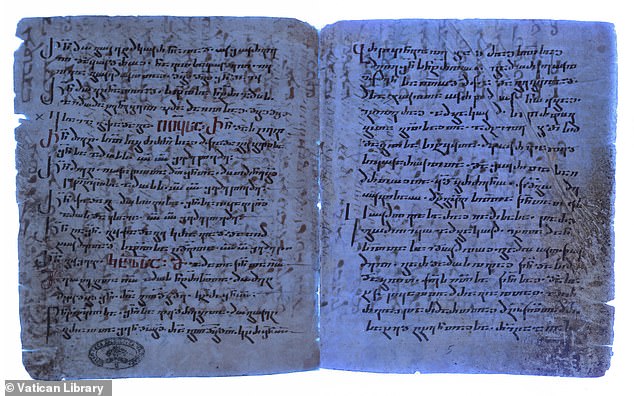Hidden Bible chapter written 1,500 years ago

Scientists have found a ‘hidden chapter’ of Bible text written more than 1,500 years ago.
The page features chapters 11 through 12 from Matthew, providing more details than today’s standard Gospel text.
Scientists uncovered the scripture after applying ultraviolet light to a manuscript about ancient Christian stories and hymns housed at the Vatican Library.
The researchers have not yet revealed a complete translation written in ancient Syriac but shared some details.
In the Greek version of Matthew chapter 12, verse one reads: ‘At that time Jesus went through the grainfields on the Sabbath and his disciples became hungry and began to pick the heads of grain and eat.
The Syriac translation reads, ‘[…] began to pick the heads of grain, rub them in their hands, and eat them.’
The initial text was written around the third century but was erased by a scribe in Palestine – a common practice because the paper made from animal skin was scarce.
The manuscript is chapters 11 through 12 in Matthew. Experts applied UV light to a document, revealing the Bible text was masked behind two layers of writing
Palimpsest Grigory Kessel, who made the discovery, told DailyMail.com: ‘The Gospel text found in this reused manuscript contains the so-called Old Syriac translations of the Gospels.
‘This Old Syriac translation quite often attests the Gospel text that is different from the standard Gospel text as we know it today.’
UV light has become popular among scientists who hope to uncover secret documents, as the hidden text absorbs the light and glows blue.
It can capture hidden text because parchment soaks in ink. And no matter how often it is reused, the original writings are still imprinted on the paper.
‘The Gospel text is hidden in the sense that the early 6th c. parchment copy of the Gospels Book was reused twice and today on the same page one can find three layers of writing (Syriac – Greek – Georgian),’ Kessel told DailyMail.com.
The Old Syriac translation of the scriptures was called ‘Peshitta’ and became the official translation used by the Syriac Church in the fifth century.
Kessel and his colleagues said the parchment was first reused for the Apophthegmata patrum in Greek, translated to ‘Sayings of the Fathers.’
The desert fathers were early Christian hermits who practiced asceticism in the Egyptian desert.
They did so around the 3rd century and eventually formed the basis of Christian monasticism.
The hidden Bible chapter was uncovered by a so-called palimpsest Grigory Kessel
Austrian Academy of Sciences scientists found the manuscript in the Vatican Library (pictured). The document was written on parchment that was reused three times. This was a common practice because paper made from animal skin was scarce
The Apophthegmata patrum is a collection of more than 1,000 of their stories and sayings and dates to the late fifth and early sixth centuries.
The next time the page was erased and reused was to copy the Iadgari of Mikael Modrekili, a Georgian manuscript of the 10th century that included a collection of hymns.
‘The tradition of Syriac Christianity knows several translations of the Old and New Testaments,’ Kessel said in a statement.
‘Until recently, only two manuscripts were known to contain the Old Syriac translation of the gospels.’
The Syriac translation was written at least a century before the oldest Greek manuscripts that have survived, including the Codex Sinaiticus – the fourth-century Christian manuscript of the Greek Bible.
Claudia Rapp, Director of the Institute for Medieval Research at the OeAW, said: ‘Grigory Kessel has made a great discovery thanks to his profound knowledge of old Syriac texts and script characteristics.’
‘This discovery proves how productive and important the interplay between modern digital technologies and basic research can be when dealing with medieval manuscripts.’
In February, it was announced that one of the oldest surviving biblical manuscripts – a nearly complete 1,100-year-old Hebrew Bible – will be up for auction in May
This amazing discovery follows the announcement that one of the oldest surviving biblical manuscripts – a nearly complete 1,100-year-old Hebrew Bible – will be up for auction in May.
Experts at auction house Sotheby’s in New York estimate it will fetch between $30 million and $50 million.
It could become the most expensive historical document ever sold at auction if the winning bid exceeds the $43.2 million paid for a first-edition copy of the Constitution of the United States.
The Codex Sassoon’ is a leather-bound, handwritten parchment book, and radiocarbon dating estimates it was created between the years 880 and 960.
Its writing style also suggests its creator was an early 10th-century scribe in Egypt or the Levant, however exactly when and where it was made is still unknown.
